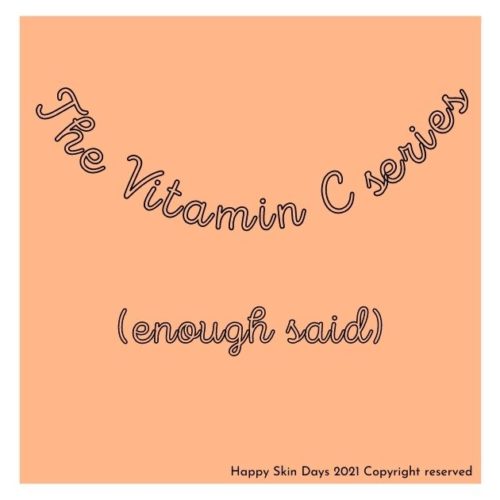Introduction
There are few ingredients that I suggest friends & family use on a regular basis. I vehemently dislike Vitamin A and I am yet to be converted on the utility of exfoliating acids (e.g.) Glycolic Acid or peptides. I am on the fence about Hyaluronic Acid.
But with Vitamin C, I am a 100% convert. I only wish I had started to use it in my twenties.
Thirty second refresher on Vitamin C
- Topical application of Vitamin C has been demonstrated to improve:
- the appearance of facial wrinkles by about 25% and this has been attributable to New collagen formation in photodamaged skin
- levels of skin-hydration
- Vitamin C is a skin-lightener as it reduces the activity of Tyrosinase, an enzyme that is essential to the production of melanin. Eumelanin is the pigment responsible for our skin colour
Back to today’s blog
Today’s blog is part of a longer more complex Vitamin C series. It would be helpful if you see today’s blog as setting the scene.
This exercise will also enable me to benchmark products in the future and help us understand ingredient label jargon.
The forms of Vitamin C
All the Vitamin C forms that I encountered are as follows:

Methodology
I use the word “methodology” with artistic licence, as my process is simple. I scour Sephora USA and cultbeauty’s websites for bestselling Vitamin C serums and add products which I think are popular. .
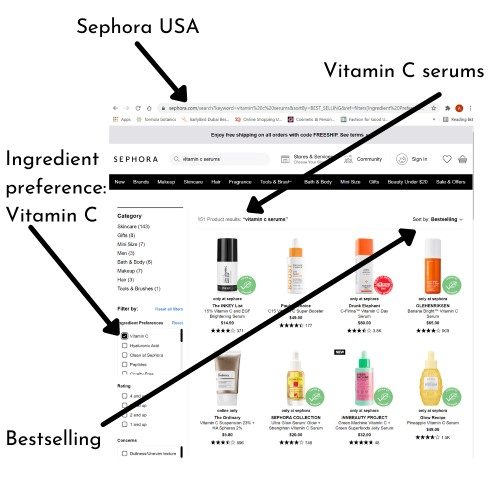
This exercise produces a list of 57 Vitamin C serums
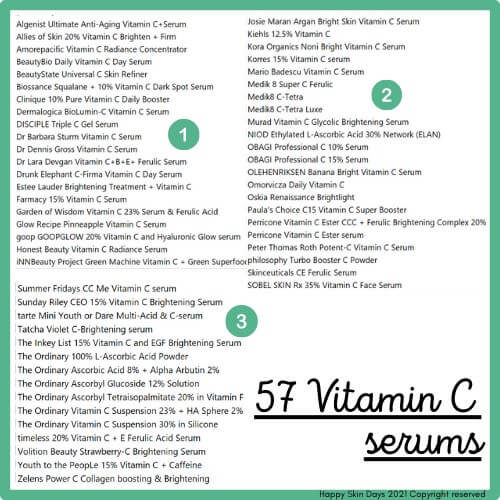
Analysing the available data (ingredient lists, % of Vitamin C composition, price etc), these are my observations
The Ordinary “6” products distort data
The Ordinary, produce so many variants of Vitamin C serums, that it simply distorts most data.
The average price of just the six Ordinary products is less than a dollar per ml or grams (powder) and you’d be tempted to believe that Vitamin C serums are cheapish.
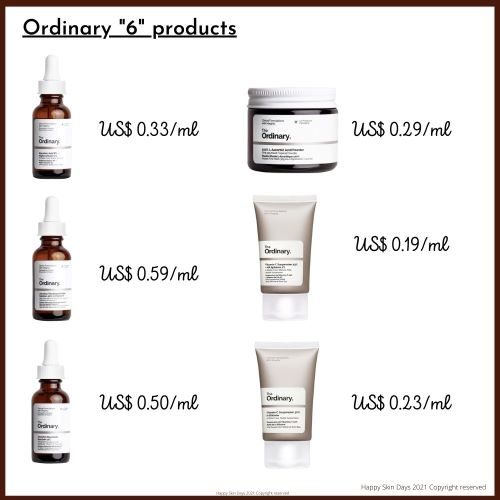
Be in no doubt, Vitamin C serums are not cheap.
The average price range of Vitamin C serums is between US$ 2/ml and US$ 3/ml

L-Ascorbic Acid is as popular as you think it is
With the Ordinary 6 products, standalone L-Ascorbic Acid is the main ingredient in 1 out of 5 products. If I expanded this to include Ascorbic Acid + Ferulic Acid + Vitamin E, L-Ascorbic Acid is the most popular form of Vitamin C. See below.
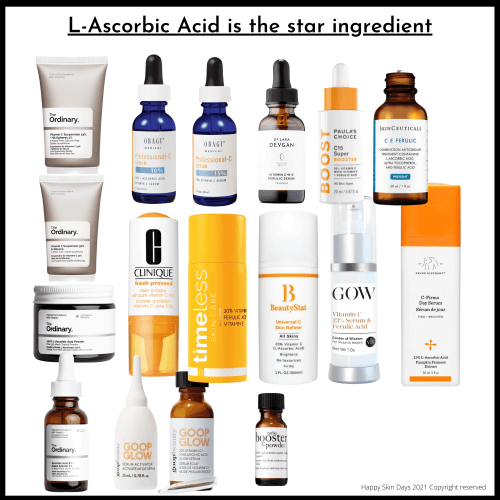
After that, the most common standalone Vitamin C ingredient is:
- THD Ascorbate followed by
- Ethyl Ascorbic Acid followed by
- Ascorbyl glucoside and Ascorbyl tetraisopalmitate
The norm is to disclose the percentage of Vitamin C in a serum
Only one-third of Vitamin C serums do not disclose the % of Vitamin C and these range from cheap to the most expensive product. Honestly, this surprised me. I assumed that the cheaper end of the market would not disclose percentages!
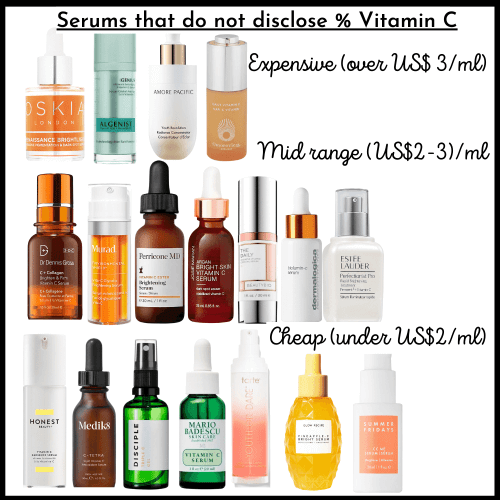
One out of three Vitamin C serums are in NOT standalone products
It is difficult to buy a serum that is just Vitamin C as the only and principal active ingredient.
In itself, this is not problematic. However, this makes comparing the performance of different Vitamin C serums very difficult because, the blended serums have actives that mimic the effect of Vitamin C.
For example, one of the primary results of using Vitamin C is skin lightening. The following ingredients all contribute to skin lightening (albeit through different mechanisms)
- Niacinamide
- Licorice extract (also, Dipotassium Glycyrrhizate, Glycyrrhiza Glabra (Licorice) Root Extract)
- Glutathione
- Exfoliating acids (by promoting rate of epidermal turnover has the effect of lightening skin). Examples include glycolic acid, lactic acid, mandelic acid, glucanolactone
Similarly one of the effects of long-term Vitamin C is increased collage production in the dermis. However, many products contain collagen amino acids and peptides and it becomes difficult to attribute a particular result (increased collagen production) to an ingredient.
Here are a few examples of products that contain Vitamin C and more
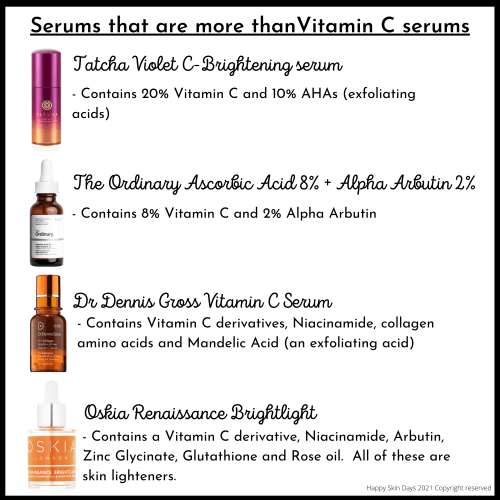
Comparing the performance of Vitamin C serums requires an algorithm
Generally, a comparison between two skincare products requires a common feature. You would think that just “Vitamin C” is enough as a common basis for comparison. Its not because Vitamin C in its pure form is L-Ascorbic Acid and then there a multitude of Vitamin C derivatives.
Manufacturers have come up with a range of combinations of ingredients that are all Vitamin C. See below
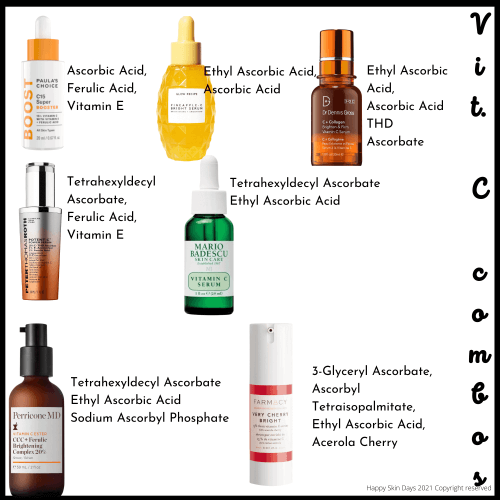
This makes comparison of the performance of Vitamin C serums very, very difficult and this is compounded by the other active ingredients that can mimic the effect of Vitamin C.
Closing
This blog took me so long to research and then forever to write. I think part of my concern was that as soon as brand’s write “Vitamin C” on their product, they expect consumers to pay a premium. Plus do we really 80 million types of derivatives for Vitamin C? You and I will just have to find out!!
